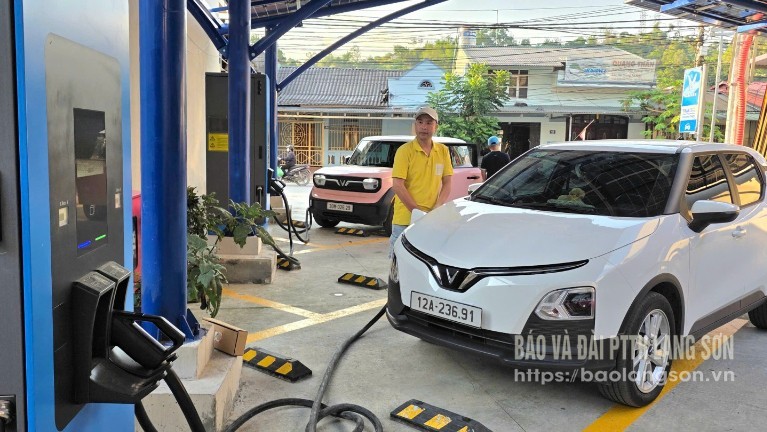Towards “Green Transportation”
Recently, the number of electric vehicles on the roads across the province has been steadily increasing. Along with the cooperation of provincial departments, sectors, and businesses in developing charging infrastructure and promoting the benefits of electric vehicles, residents are gradually shifting their consumption habits towards “green transportation.”

These days, when traveling through Dong Kinh, Ky Lua, Tam Thanh, or Luong Van Tri wards, one can easily notice the growing presence of electric vehicles, ranging from e-bikes and electric motorcycles to electric cars. These clean-energy vehicles are becoming a common choice in the daily lives of local people.
Bringing his car to a charging station, Mr. Pham Duc Canh, a resident of Dinh Tien Hoang street, Luong Van Tri ward, shared: “I chose an electric car because it suits my needs for commuting around the city. The car runs smoothly, without noise or odors. Most importantly, it emits no CO₂, allowing me to make a small contribution to environmental protection.”
| By the end of 2024, the province had nearly 42,500 registered and operational cars, with electric cars accounting for about 17%. In addition, more than 29,900 electric motorcycles were in use across the province. Since the beginning of 2025, the green transport trend has continued to rise, with 260 new electric cars and nearly 600 new electric motorcycles registered. |
At the same charging point, five other vehicles were also being charged—an image that is becoming increasingly common in urban areas.
The growth of electric vehicles is not only reflected in their numbers on the road but also in the rising demand for purchase. At the same time, local businesses have begun ramping up the production and distribution of electric vehicles to meet this trend.
In Lang Son, DK Vietnam - Japan Electric Vehicle Co., Ltd. is one of the pioneers in developing electric vehicles. Ms. Hoang Minh Hanh, Head of the company’s Sales Department, said: “Recently, demand for electric vehicles has increased significantly. People are paying more attention to energy-saving and convenient means of urban transportation. Our company currently distributes 15 models of electric motorcycles, suitable for various customer groups, particularly students and urban residents with short-distance travel needs. On average, our production volume is about 150 vehicles per day, increasing to 250 per day during peak seasons. To encourage local residents to use green vehicles, the company has launched special promotional programs for each model.”
According to the Traffic Police Division of the Provincial Public Security, by the end of 2024, Lang Son had nearly 42,500 registered and operational cars, with electric cars making up about 17%. Additionally, more than 29,900 electric motorcycles were in circulation. Since early 2025, the use of green vehicles has continued to increase, with 260 new electric cars and nearly 600 new electric motorcycles registered.
Mr. Dinh Ky Giang, Deputy Director of the Department of Industry and Trade, said: “Recently, the number of electric-powered vehicles in the province has increased significantly. As residents prioritize electric vehicles, they benefit from lower operating and maintenance costs. More importantly, electric vehicles emit no CO₂ during operation, helping to improve air quality and protect the environment. In the coming time, the Department will continue to work with relevant agencies to promote supportive policies, encourage businesses to invest in developing charging infrastructure to meet rising demand, and move towards the goals of energy saving, emission reduction, and sustainable development.”
Electric vehicles are increasingly seen as a suitable choice that contributes to realizing the province’s sustainable transportation goals. According to preliminary statistics, the province currently has about 20 charging stations for electric cars. Relevant agencies are surveying the current infrastructure to build plans for improvement, especially the development of public charging stations, so residents can feel more secure when using electric vehicles.
The shift to electric vehicles is not only about changing the mode of transportation but also about transforming mindsets—from short-term convenience to sustainable choices for the future. For this journey to truly succeed, close cooperation between the government, businesses, and the community is essential. Authorities need to continue investing in infrastructure and developing safe battery disposal solutions; businesses must expand charging networks; and citizens should actively adopt green lifestyles and responsible consumption.
 Loading
Loading  Tiếng Việt
Tiếng Việt English
English 中文
中文


